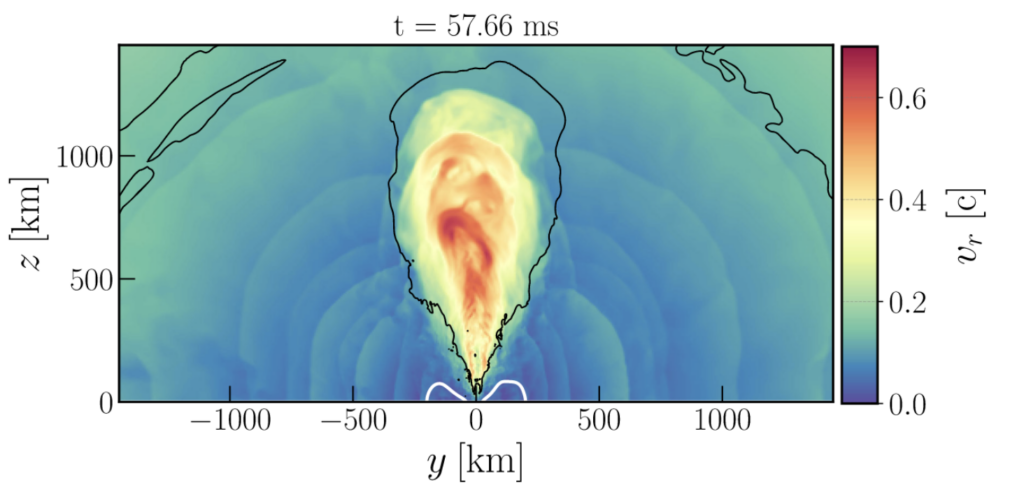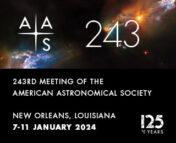Title: Jets from Neutron-Star Merger Remnants and Massive Blue Kilonovae
Authors: Luciano Combi and Daniel M. Siegel
First Author’s Institution: University of Guelph, Guelph, Ontario, Canada
Status: Published in The Physical Review Letters [closed access] (arXiv open access)

Neutron stars
Neutron stars (NSs) are the most extreme objects known, composed of a form of matter so extraordinarily dense that it teeters on the brink of collapse into a black hole. Neutron stars are the dead, leftover cores of massive stars that have ended their lives in a core-collapse supernova (CCSNe). When stars >10 to 20 times the mass of the Sun are living, they fuse elements starting with hydrogen (atomic mass of 1) up through iron (atomic mass of ~56). Continuing fusion is no longer energetically favorable at this point because it requires more energy to fuse iron than the reaction produces. Eventually, the star exhausts its supply of fusible material, and the iron core can no longer keep itself from collapsing. As the gravitational collapse proceeds, the extreme force overcomes the electromagnetic repelling force between positively charged protons and negatively charged electrons, forcing them into one another, creating neutrons and electron neutrinos in a weak-force-driven process called electron capture or inverse beta-decay. (Note that this process occurs in regular CCSNe but differs from an “electron capture supernova”). If the mass of the core remains low enough, then the remaining neutrons provide a final defense against a runaway collapse into a black hole called neutron degeneracy pressure. Through a mechanism that is not well understood yet, the stellar envelope surrounding the core as this collapse is happening absorbs energy from this event. It transports it outward into free space, which we observe as a supernova, leaving behind the NS.
A deadly dance
If a neutron star is already dead, how could it possibly die again? One method is through a binary neutron star (BNS) merger. If two NSs become gravitationally bound together, they will orbit around one another for millions or billions of years, radiating away energy via gravitational waves. According to Kepler’s laws and the Virial Theorem, the energy in a gravitationally bound system will decrease as the two objects move closer together. This effect is called “inspiraling,” which, after enough time, will result in the eventual collision of the two NSs into a single object. This remnant merged neutron star can remain stable for a very short time (tens to hundreds of milliseconds) before the significant mass is enough to overcome the neutron degeneracy pressure that was initially holding each star up, causing the remnant to collapse into a black hole eventually. The light we observe from this extreme event is called a kilonova. Theorized in 1998, a kilonova is much less luminous than the CCSNe that produced each component of the BNS but is still about a thousand (kilo-) times the luminosity of a regular stellar explosion (nova) and was appropriately named as such by theoretical astrophysicist Brian Metzger in 2010.
Although we regularly observe CCSNe, we have only observed one confirmed kilonova, GW170817. BNS mergers are the ultimate multi-messengers: first alerted by LIGO and Virgo, Fermi and Swift observed a short-duration gamma-ray burst (sGRB), and an optical counterpart was discovered shortly after in NGC4993 (neutrino emissions are predicted but were not detected). The early (~one day) optical emission was blue and UV-bright and eventually faded to give way to a longer-lived (~weeks) red component. This seemingly long-lasting electromagnetic (EM) emission is hard to explain via the merger itself stirring up debris, given its relatively short length. Many models for the optical emission from KNe rely on the nature of the neutron-rich environment. A BNS merger can produce many of the heaviest elements through nucleosynthesis via the rapid-neutron capture process (r-process). This material is ejected in the merger and radioactively decays, creating the optical light called a kilonova. This process also explains how the Universe’s heaviest elements are seeded.
The attack: how to model a kilonova
Although this picture for a kilonova is very satisfying, several open questions remain. Winds from an accretion disk around the final black hole explain the weeks-long, redder optical emission well, but the explanation of the early day-long blue and UV emission is not as clear. This paper aims to explain the early blue component observed in GW170817 by creating a simulation for the first few hundred milliseconds of a BNS merger that includes almost all relevant physics. Since we don’t completely understand what makes up NSs, they select a specific prescription for the neutron star equation-of-state (EOS), which results in the longest-lived NS remnant after the merger occurs. This long-lived remnant is important because the authors are determining how long the remnant must survive before collapsing into a black hole to power the launch of a relativistic jet that could potentially explain the UV/blue emission. Radio observations at late times of GW170817 have also indicated that a significant amount of material was ejected and is well-explained by the afterglow of a structured jet, providing more motivation for investigating the possibility of a jet.
A jet is born
The simulation begins: our two neutron stars begin their in-spiral towards the inevitable merger. For the first two milliseconds, starting at the merging time (t = 0ms), the magnetic field of the remnant NS exponentially grows due to the Kelvin-Helmholtz instability. Simultaneously, in the first 15 ms, large-scale eddies inside the remnant NS form vortices around the innermost core of the remnant that convert kinetic energy into magnetic energy, amplifying the toroidal magnetic field further, scaling proportionally with the time-after-merger squared. Finally, differential rotation sets in, driving a linear growth of the toroidal magnetic field. The turbulent fields are converted into an ordered, large-scale structure that drives twin jets along the orbital axis of the original two NSs. The bottom panel of Figure 1 illustrates the mean magnetic field at 15ms and 50ms, which shows the magnetic tower responsible for the jets. This structure extends >100km within the first 50ms!
Before this magnetic structure emerges, material along the polar regions is initially accelerated by the significant neutrino radiation from the remnant NS. Similar to CCSNe, the gravitationally unbound material absorbs the energy from the neutrinos, converting it into kinetic energy and creating a wind with a typical velocity of 10% the speed of light and a “steady-state” wind that has a density that falls off like the distance-squared. The mass loss at this time is dominated by spiral waves that propagate outward through the accretion disk, which is visible as shells in Figure 2.

As the magnetic field grows and this structure breaks through the merger debris, an outflow of material dominated by the magnetic field emerges, and a similar wind profile emerges. The funnel formed by this structure rapidly increases the kinetic energy of the outflowing material, increasing its speed to 25%-60% the speed of light. Within about 15ms, more than half of the total mass that will be ejected is rapidly unbound. Although the jet is responsible for the highest velocity ejecta, the authors find that most of the ejected material comes from the wind off the accretion disk that rapidly grows due to a reconfiguration caused by the onset of the emerging jet magnetic structure.
But what do we observe?
The authors use their simulation to create a synthetic light curve to determine whether this process could be responsible for the early blue emission in GW170817. After the merger event, the authors add tracer particles to the ejecta, keeping track of their composition (electron fraction), radial velocity, and neutrino irradiation. They extract the final 3D mass profiles as a function of radius from the BNS merger event and use a nucleosynthesis code to predict the resulting emission due to the radioactive decay as a function of the viewing angle. They find that along the direction of the jet (despite there being less ejected mass in that direction), the blue optical luminosity of the kilonova is significantly enhanced for the first few hours after the merger. The authors note that this is a potential “precursor signal” to the main kilonova event and could potentially be a way of discriminating between BNS mergers and NS-black hole mergers, which wouldn’t display this precursor signal.
In a final demonstration of their simulation, they compare to our friend GW170817. When they place their simulation at the appropriate distance and viewing angle and compare it to the observed optical light curves, they find that their simulation accurately predicts the early blue component of the kilonova. These results indicate that the remnant NS in a BNS merger must only last for ~50ms, and they find that outflows from the accretion disk drive most of the ejected mass.
Astrobite edited by Cesiley King
Featured Image Credit: Robin Dienel/Carnegie Institution for Science




